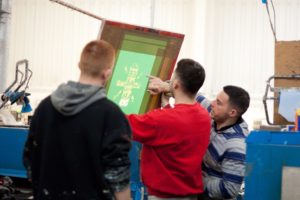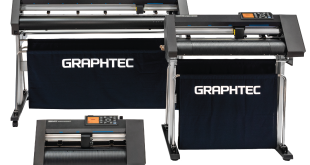
There is one thing that we have never been able to iron out, which I think is a common problem in our industry? The inevitable winter dip and the wider effect it has on staffing and training. Arron Harnden of Shirtworks explains further.
From December through to February there seems to be less interest in buying screen printed or embroidered clothing and the almost impossible to manage summer peaks drop rapidly into sleepier winter troughs.
The effect of this annual dip forces us to focus on managing costs carefully at this time, and unfortunately this means adopting a staff plan that involves expansion and contraction to deal with the drop in winter revenues.
Get up to speed
Screen printing and embroidery production require skills that cannot be learned overnight. A good deal of time and patience is invested into newbies to get them up to speed and to a level where they can contribute to the fast pace of production without causing expensive mistakes.
They need to be watched like a hawk, their work checked and then checked again. This is a burden to the trainer who is most likely wrestling with their own production problems and deadlines. The distracted trainer creates a variable experience for each student because there is often no time to formalise and structure training in a logical, linear way; they are forced to coach on the run.
It is an annually repetitive burden that could be alleviated if the formal education system recognised screen printing and embroidery as a possible career path for practically minded students who did not want to enter into the protracted and expensive system of academic higher education.
Germany, Poland and Australia are just some of the more enlightened countries that take screen printing seriously and produce energetic college graduates to fill the ranks.
Much needed skills
There are thousands of businesses in the UK who could put keen young minds into paid summer work, augmenting their studies, or into a job as soon as they graduate if they were trained to have the skills that we need in the screen print industry.
On paper, it does appear possible to gain an NVQ/SVQ in printing, but finding a local college which is able to provide the training and equipment required to gain the qualification seems impossible.
This is not surprising, as all colleges are commercial interests requiring bums on seats. It makes more financial sense to fill a room with 40 computer terminals to provide a training course, than it does to fill a large classroom with carousels and dyers.
In-house training from scratch is therefore inevitable.
There are three ways to get someone up to speed:
- Make it up as you go along, training your newbies while on the job, accept that their mistakes will cost you time and money and their training experience is fractal and disjointed.
- Find time to develop an in house training document, or apply to become an apprenticeship provider and accept that you will have a mountain of red tape, paper work, box ticking and inspections to attend to just to get yourself a cheap young blood into the workforce.
- Cherry-pick from the NVQ level 2 and level 3 printing syllabus and give it to your production managers as their framework guide to formal training, along with your own in house training material.
The following would be pertinent to the newbie screen printer:
- Unit 201 – Maintain health and safety within a print related working environment.
- Unit 203 – Knowledge of the organisations printing processes and related information.
- Unit 204 – Keep equipment clean and in working order for use in the printing industry.
- Unit 205 – Set up and run machinery within the print industry.
- Unit 212 – Prepare stencils for printing.
- Unit 214 – Prepare inks and coatings for printing.
- Unit 310 – Machine printing (screen).
If a training framework exists then you reduce variability, develop standard operating procedures and cognitive synchronicity.
If a training framework exists you reduce errors, re-dos and financial loss.
If a training framework exists you create a culture with higher quality expectations and output.
Once the newbie has reached that point where the training wheels can come off, they can be left to run wild and free through your workshop during the busy spring, summer and autumn periods.

The shame of it all for us as a business is that the sleepy trough looms on the horizon, and we are destined to repeat the training exercise again and again and again.
The real shame is that we lose one or two good people that we have spent time and sometimes painful effort training, as we are forced to contract the workforce each winter.
The really real shame of it all is that even while I write these glittering words, I know that we often fail to implement training in a formal and structured manor, instead relying on the make do and get by methods that a frenetic workshop dictates.
If only I could send them to screen printing bootcamp or find a winter business to buy…
 Printwear & Promotion The Total Promotional Package
Printwear & Promotion The Total Promotional Package




